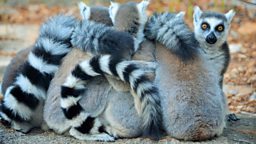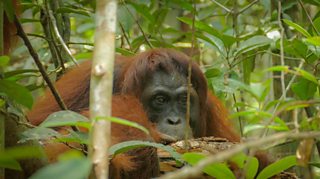Lemurs, wonderful lemurs
By Professor Marni LaFleur

Lemurs, the primates found only on the island of Madagascar, are amazingly diverse. There are over 100 species of extant lemur, which range in size by more than 300-fold, as Madame Berthae’s miniature mouse lemur is just 30-grams, and the indri weigh up to 9.5 kilograms. Other remarkable traits include the ability to hibernate for seven months of the year (dwarf lemurs), consume deadly levels of cyanide (bamboo lemurs), grow astoundingly large testes during the mating season (giant mouse lemur), and even the possession of a 6th digit on their hands (aye-aye).
all lemurs share a trait that is unusual within mammals: female dominanceMarni LaFleur
In addition to species specific diversity, all lemurs share a trait that is unusual within mammals: female dominance. Female ring-tailed lemurs are unequivocally dominant to same-sized males, and even a glance from a female can send a male running and yelping in submissive squeals. Of the roughly 5400 species of wild mammals, only spotted hyenas, naked mole rats, and the lemurs boast female dominance. Lemur females likely gain a much-needed nutritional advantage by way of their dominance, which is necessary to survive and reproduce on their island habitats where food resources can be scarce and unpredictable.
Why are these Malagasy primates so diverse and unusual? Long isolation, a plethora of available niches, and island living can likely account for their seemingly strange traits. Ancestral lemurs ‘rafted’ to Madagascar approximately 60 million years ago, wherein they adapted to both wet and dry habitats, with few competitors or predators. In fact, it wasn’t until about 20 million years ago that the fossa made it to Madagascar. Thus, lemurs had free reign of Madagascar for millions of years and their evolution ran wild.

Sadly, lemurs are now considered the most endangered group of mammals by the IUCN (International Union for Conservation of Nature), as greater than 94% of lemurs are at risk of extinction. In fact, 17 species of giant lemur have already gone extinct since humans began inhabiting Madagascar. These recently extinct species included a sloth-like lemur, koala-like lemur, and even gorilla-sized indri relative. Today, the northern sportive lemur has fewer than 100 individuals remaining in the wild, and like many other leaf-eating lemur species, the northern sportive cannot survive in captivity.
Wildlife tourism can be of great benefit to communities if undertaken responsibly.Marni LaFleur
The three main threats to lemur survival are habitat loss, bushmeat hunting and live capture for the within-country trade of pets. Many of these threats are driven by human poverty. Madagascar is one of the poorest countries on earth and has the lowest GDP of any non-conflict nation. Humans living in extreme poverty (less then 2 dollars per day) rely on forest resources for daily subsistence, including wood for fuel, bushmeat (in some areas), and other extracted products for personal use or sale. The situation can be exacerbated by the exploitation a few globally prized natural resources, such as rosewood, endemic tortoises, gem stones, and other mined products. Legal and illegal exploitation of plants, animals and landscapes in Madagascar further imperil its poorest citizens and endemic wildlife.
But, it is not yet too late for lemurs! There are several excellent organisations working tirelessly to build local capacity and save endemic species from exploitation and extinction. Moreover, Madagascar’s youth, its largest demographic, are energised and eager to protect their country’s natural resources. They need our help though - infrastructure and training are often lacking, and financial support is practically non-existent. Wildlife tourism can be of great benefit to communities if undertaken responsibly. You can check the for advice and for organisations based in and working in Madagascar, who are investing in Madagascar’s young people and fostering environmentalism- we can all support these organisations by promoting them online and donating to their important work.



